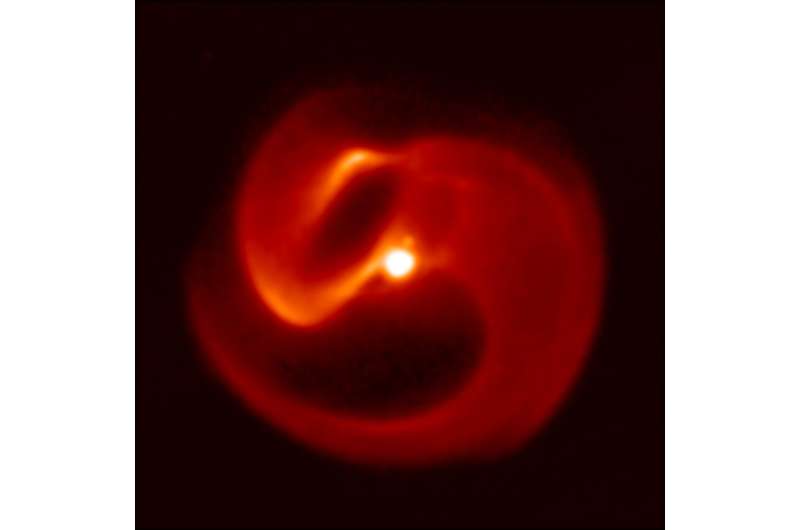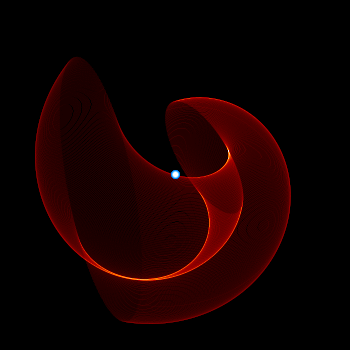This is an image of Apep captured at 8 microns in the thermal infrared with the VISIR camera on the European Southern Observatory's VLT telescope, Mt Paranal, Chile. The system can be seen to be a binary, with a much fainter companion to the North of the heart of the system. This companion is not believed to play a role in the sculping of the extended dust plume, about 12 arcseconds across. The origin of this structure comes from the central region, believed itself to contain a binary (the whole thing being a triple star). Credit: Peter Tuthill/University of Sydney/ESO
University of Sydney astronomers, working with international colleagues, have found a star system like none seen before in our galaxy.
The scientists believe one of the stars—about 8000 light years from Earth—is the first known candidate in the Milky Way to produce a dangerous gamma-ray burst, among the most energetic events in the universe, when it explodes and dies.
The system, comprising a pair of scorchingly luminous stars, was nicknamed Apep by the team after the serpentine Egyptian god of chaos. One star is on the brink of a massive supernova explosion.
The findings, published today in Nature Astronomy, are controversial as no gamma-ray burst has ever been detected within our own galaxy, the Milky Way.
Yet in the southern constellation of Norma, nestled just beneath Scorpio's tail, astronomers have discovered this uniquely beautiful star system.
At its heart, wrapped in an elegantly sculpted plume of dust and gas, lies a powerful binary pair.
The two hot, luminous stars—known to astronomers as Wolf-Rayets - orbit each other every hundred years or so, according to the research conducted at the Sydney Institute for Astronomy.
This orbital dance is embossed on a fast wind streaming off the stars. Using spectroscopy, the astronomers have measured the velocity of the stellar winds as fast as 12 million kilometres an hour, about 1 percent the speed of light.
This animated gif is intended to illustrate the geometry of the structure that we have witnessed in the Apep system. From a single image, it is harder to understand the 3-D structure. The central binary (only: not the wider Northern companion in the triple) is illustrated as the blue star at the centre. The geometry given is that believed typical for a Wolf-Rayet colliding pinwheel system: that is an optically thin dust plume distributed over the surface of a cone that is dictated by the colliding winds. The whole outflow structure is wrapped into a spiral by the orbital motion of the presumed central binary. Further the dust formation has a specific onset and cessation, which truncate the spiral at the outer and inner limits (for example, giving rise to the notable elliptical hole). Note this is a toy animation to illustrate a fly-around of the structure, and not a model fitted to the data that describes the dust flow process. The looping animation proceeds for about half an orbit (say roughly 60 years) with a pause at about the present epoch. Note that the motion we actually recorded with VISIR in the real data only spans 3 years. Credit: Peter Tuthill/University of Sydney/ESO
Dr. Joe Callingham, lead author of the study, said: "We discovered this star as an outlier in a survey with a radio telescope operated by the University of Sydney.
"We knew immediately we had found something quite exceptional: the luminosity across the spectrum from the radio to the infrared was off the charts," said Dr. Callingham, who is now at the Netherlands Institute for Radio Astronomy.
"When we saw the stunning dust plume coiled around the these incandescent stars, we decided to name it 'Apep' - the monstrous serpent deity and mortal enemy of Sun god Ra from Egyptian mythology."
That sculpted plume is what makes the system so important, said Professor Peter Tuthill, research group leader at the University of Sydney.
"When we saw the spiral dust tail we immediately knew we were dealing with a rare and special kind of nebula called a pinwheel," Professor Tuthill said.
"The curved tail is formed by the orbiting binary stars at the centre, which inject dust into the expanding wind creating a pattern like a rotating lawn sprinkler. Because the wind expands so much, it inflates the tiny coils of dust revealing the physics of the stars at the heart of the system."
However, the data on the plume presented a conundrum: the stellar winds were expanding 10 times faster than the dust.
"It was just astonishing," Professor Tuthill said. "It was like finding a feather caught in a hurricane just drifting along at walking pace."
Dr. Benjamin Pope, a co-author from New York University, said: "The key to understanding the bizarre behaviour of the wind lies in the rotation of the central stars.
"What we have found in the Apep system is a supernova precursor that seems to be very rapidly rotating, so fast it might be near break-up."
Wolf-Rayet stars, like those driving Apep's plume, are known to be very massive stars at the ends of their lives; they could explode as supernovae at any time.
"The rapid rotation puts Apep into a whole new class. Normal supernovae are already extreme events but adding rotation to the mix can really throw gasoline on the fire."
The researchers think this might be the recipe for a perfect stellar storm to produce a gamma-ray burst, which are the most extreme events in the Universe after the Big Bang itself. Fortunately, Apep appears not to be aimed at Earth, because a strike by a gamma-ray burst from this proximity could strip ozone from the atmosphere, drastically increasing our exposure to UV light from the Sun.
"Ultimately, we can't be certain what the future has in store for Apep," Professor Tuthill said.
"The system might slow down enough so it explodes as a normal supernova rather than a gamma-ray burst. However, in the meantime, it is providing astronomers a ringside seat into beautiful and dangerous physics that we have not seen before in our galaxy."
More information: J. R. Callingham et al, Anisotropic winds in a Wolf–Rayet binary identify a potential gamma-ray burst progenitor, Nature Astronomy (2018). DOI: 10.1038/s41550-018-0617-7
Journal information: Nature Astronomy
Provided by University of Sydney

























